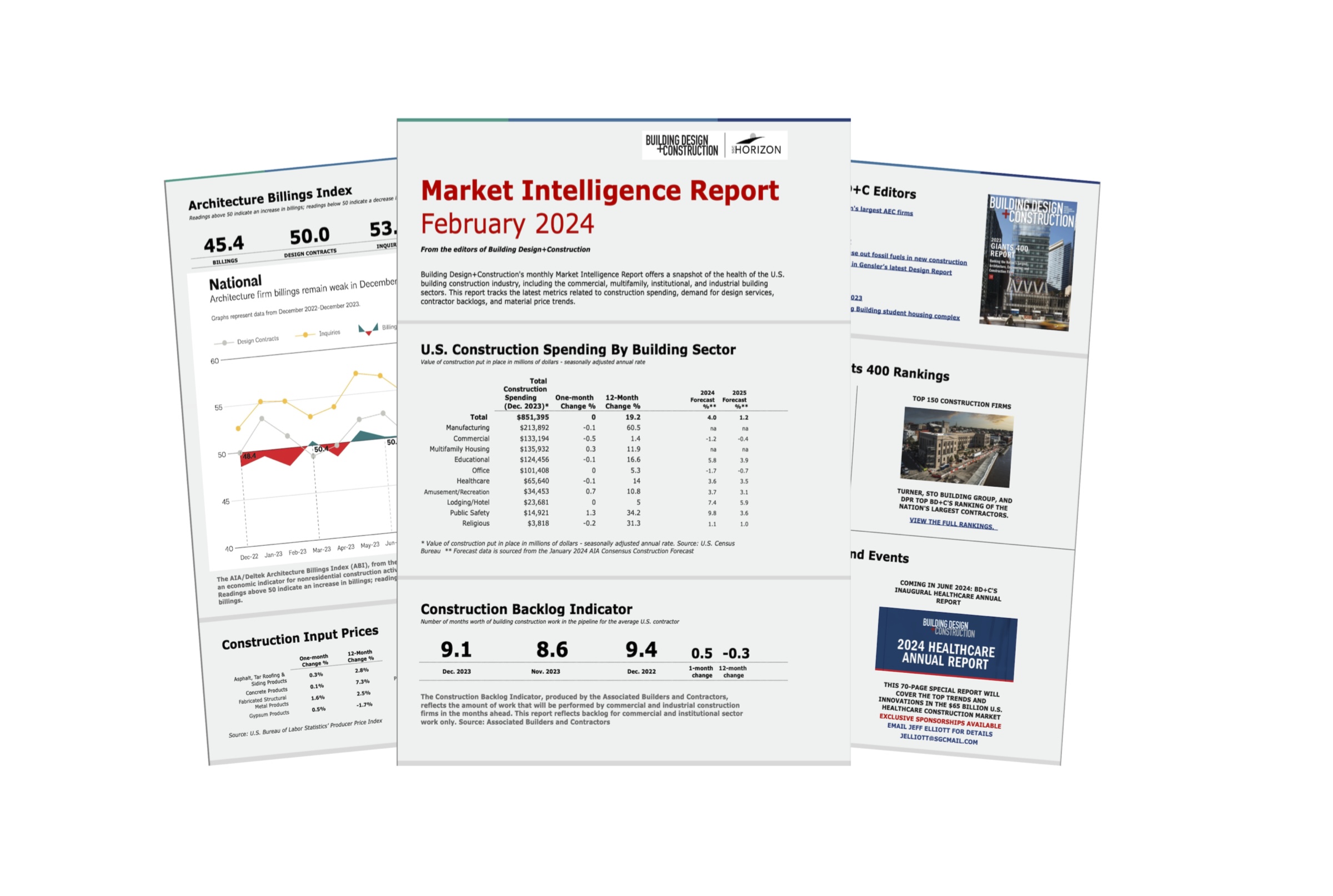Building Design+Construction's monthly Market Intelligence Report offers a snapshot of the health of the U.S. building construction industry, including the commercial, multifamily, institutional, and industrial building sectors. This report tracks the latest metrics related to construction spending, demand for design services, contractor backlogs, and material price trends.
Data for the Market Intelligence Report is gleaned from reputable economic sources, including the American Institute of Architects, Associated Builders and Contractors, and the U.S. Census Bureau.
Here are some of the highlights from the February 2024 report:
- Spending on vertical construction (i.e., "commercial buildings" work) is at a near all-time high, at $851.4 billion in annualized spending. However, inflation plays into this equation; building projects are more costly to plan, design, and build.
- Multifamily continues to shine, with 11.9% YOY growth to $135.9 billion in annual spending. Economists are calling for a slowdown, but not until 2025-26. Even at that, construction spending will hover at near all-time highs.
- Other hot sectors: manufacturing, education, healthcare, public safety, and religious.
- The 2024-25 forecast (from AIA) for key markets looks promising; only commercial/retail and office are expected to see a pullback in construction spending. Hotels, multifamily, education, and healthcare are all expected to see strong spending increases.
- The average U.S. contractor currently has 9.1 months worth of building construction work in the pipeline, which is slightly higher for the month and on par with the previous year.
- AIA's Architecture Billings Index has remained below 50 for the past six months, which means more firms than not are experiencing a decrease in billings.
- Construction material prices have largely stabilized. We're not seeing the volatile swings in prices and availability experienced during the pandemic.
Related Stories
Market Data | Oct 2, 2019
Spending on nonresidential construction takes a step back in August
Office, healthcare, and public safety are among the fastest-growing sectors, according to the U.S. Census Bureau's latest report.
Market Data | Sep 27, 2019
The global hotel construction pipeline ascends to new record highs
With the exception of Latin America, all regions of the globe either continued to set record high pipeline counts or have already settled into topping-out formations amidst concerns of a worldwide economic slowdown.
Market Data | Sep 25, 2019
Senate introduces The School Safety Clearinghouse Act
Legislation would create a federally funded and housed informational resource on safer school designs.
Market Data | Sep 18, 2019
Substantial decline in Architecture Billings
August report suggests greatest weakness in design activity in several years.
Market Data | Sep 17, 2019
ABC’s Construction Backlog Indicator inches lower in July
Backlog in the heavy industrial category increased by 2.3 months and now stands at its highest level in the history of the CBI series.
Market Data | Sep 13, 2019
Spending on megaprojects, already on the rise, could spike hard in the coming years
A new FMI report anticipates that megaprojects will account for one-fifth of annual construction spending within the next decade.
Architects | Sep 11, 2019
Buoyed by construction activity, architect compensation continues to see healthy gains
The latest AIA report breaks down its survey data by 44 positions and 28 metros.
Market Data | Sep 11, 2019
New 2030 Commitment report findings emphasize need for climate action
Profession must double down on efforts to meet 2030 targets.
Market Data | Sep 10, 2019
Apartment buildings and their residents contribute $3.4 trillion to the national economy
New data show how different aspects of the apartment industry positively impact national, state and local economies.
Market Data | Sep 3, 2019
Nonresidential construction spending slips in July 2019, but still surpasses $776 billion
Construction spending declined 0.3% in July, totaling $776 billion on a seasonally adjusted annualized basis.
















